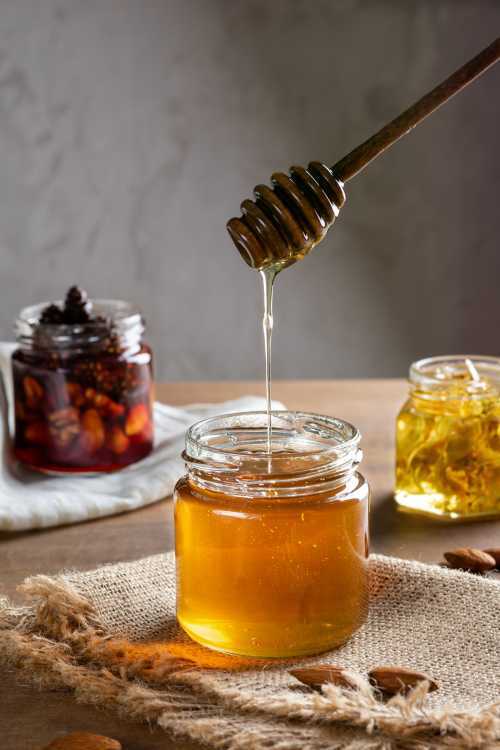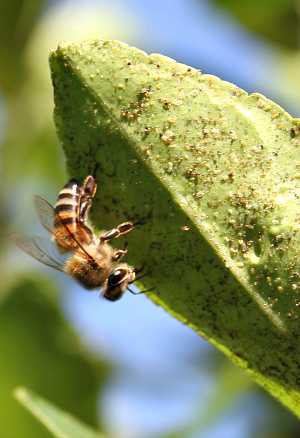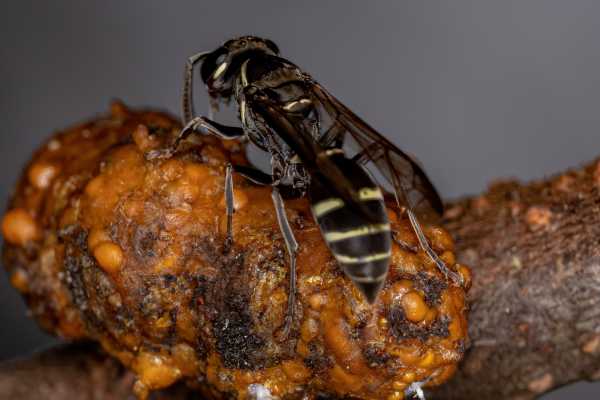What’s The Difference Between Nectar And Honey?
Although both nectar and honey are famously sweet, they are not the same. Here, we’ll look at the differences between nectar and honey.
5 Key Differences Between Nectar And Honey
Nectar and honey each have a number of specific characteristics and features that serve to differentiate one from the other.
In short, nectar is a primary ingredient of honey, which is then turned into honey by honey bees.
1. Nectar Is Made By Flowers, Honey Is Made By Bees
Nectar is a sweet substance made by plants in glands called nectaries.
Nectar is secreted from inside flowers but also sometimes from nectaries located in leaves on certain plants.
Whilst most nectar is gathered by bees from within flowers, they will sometimes take it from extra-floral nectaries found on leaves.
Honey, on the other hand, is a sweet product made by bees, and not by flowers or plants. Flowers do not secrete ready-made honey!
Nectar must pass through processes instigated by the bee in
order for it to be transformed into honey, including:
- Addition of the bee’s
own enzyme
This enzyme plays an important role in transforming nectar into honey, ultimately turning honey into an acidic food that will store well and is resistant to bacteria; and - Evaporation of the nectar water content
This serves to concentrate the sugar and other ingredients in the nectar.

2. Difference Between The Composition of Nectar And Honey
Nectar is mostly made up of water and different sugars, but it also contains traces of proteins, salts, acids, and floral oils.
Not all flower nectars are the same, they do in fact vary
between flower species and have different aromatic qualities.
For example, the nectar inside flowers
of the rosemary bush is different from that made by a crocus flower.
Each flower’s nectar is unique to the flower type.
Honey, despite being made from nectar, also contains ingredients other than nectar, most
notably as mentioned previously, the bee’s own enzyme, added by the bee.
Natural, raw honey in the comb will also contain
traces of other plant products, such as flower pollen, as well bee products,
such as traces of wax and debris. These
are generally filtered out unless raw honey is purchased.
Since
honey often comprises nectar from multiple flower sources (multi-floral honey), it therefore contains
all the combined ingredients offered by the various unique nectars.
Alternatively,
mono-floral honeys consist of nectar mainly from one particular plant
type. One example is Manuka honey, a
plant which produces a nectar that when turned into honey by bees, offers a
number of therapeutic benefits.
3. Difference In Natural Function Of Nectar And Honey
Nectar secretion serves a variety of functions in different
plants, including:
- Attracting pollinators
Nectar serves as a food reward to encourage insect visits from bees and other pollinators, thus facilitating insect pollination. - Defence: attracting a predator of key plant pests
Some plants are known to secrete nectar from extra-floral nectaries on plant leaves in order to attract insects that in turn, will help to protect the plant.
For example, Acacia trees attract ants in this way, which in turn deter other insects that might damage or eat the plant. - Attracting insects for food
Carnivorous plants entice insects via this method, in order to trap and consume them.
Whilst nectar mostly serves to attract pollinators such as bees to flowers, other nectars can actually be harmful to some insects, including bees, whilst other flower nectars serve as a deterrent.
From the perspective of bees, where plants offer nectar as a pollinator reward,
they may also offer different benefits, such as anti-bacterial properties as
found in nectar of some herbs, such as Thyme.
Flower nectar
therefore helps to provide not only energy (in the form of sugar) to bees, but
also provides other ingredients beneficial to bee health.
Honey is a food made by bees as a means to store food for the winter, thus sustaining the bee colony when they are unable to forage for food. See Why do bees make honey?
4. Commercial Availability
Jars of raw nectar are not available to purchase in supermarkets, unless you include within your definition, products made from sweet sap of plants and trees.
Such products would include agave nectar (sometimes referred to as cactus
honey, made from the sap of the Agave plant) and maple syrup (harvested from
beneath the bark of maple trees).
Arguably, these products are technically not quite the same as nectar,
since nectar is the phloem sap that is modified by nectary cells.
Honey is harvested by beekeepers and is of course available
commercially in a variety of formats and colors.
Also see: What is honey?
5. Texture
Nectar is primarily composed of water.
Honey has a high water content, but during the transformation of nectar into honey, honey bees fan their wings to evaporate some of that water content.
Honey is therefore thicker than nectar, and more viscous.
Can bees make honey from substances other than nectar?
 Honey bee feeding on aphid secretions.
Honey bee feeding on aphid secretions.Bees can make honey from aphid secretions. Read about honeydew honey.
Resources
- See links within the article to further information on this website.
- Vassilyev AE. On the mechanisms of nectar secretion: revisited. Ann Bot. 2010 Mar;105(3):349-54. doi: 10.1093/aob/mcp302. Epub 2010 Jan 5. PMID: 20053630; PMCID: PMC2826252.
If you found this page helpful or interesting, I'd really be grateful if you would share it with others - if not this page, perhaps another, such as Gardening For Bees.
Thank you so much :) .
